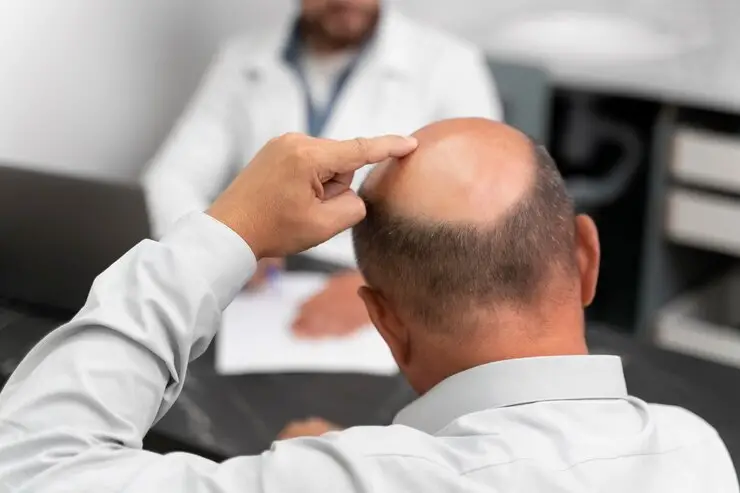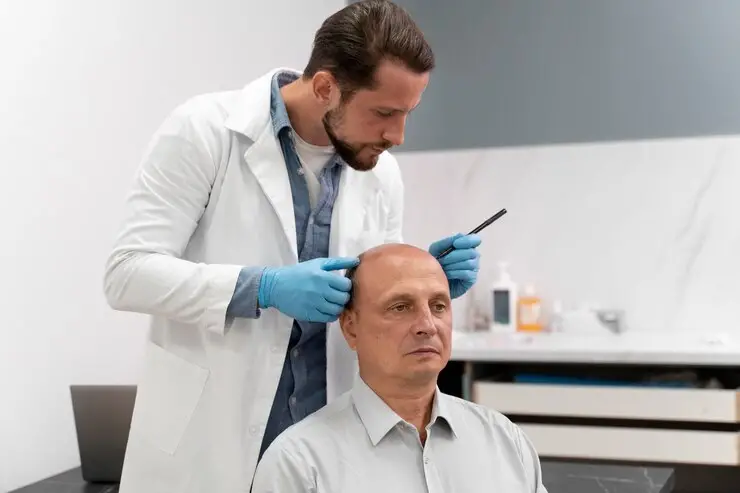Exploring Hair Loss Alopecia and its Impact

Hair loss, medically known as alopecia, can have a profound impact on an individual’s physical appearance, self-esteem, and overall well-being. Whether it manifests as thinning hair, bald patches, or complete hair loss, alopecia is a condition that affects millions of people worldwide. In this article, we’ll delve into the causes, types, and emotional implications of hair loss, as well as explore potential treatments and coping strategies for those affected by alopecia.

Page Contents
Exploring Hair Loss Alopecia and its Impact

1. What is Alopecia?
Alopecia is a medical term used to describe hair loss or thinning of the hair. It can occur on the scalp or other parts of the body and may present in various forms, ranging from mild to severe. Alopecia can be temporary or permanent, and its causes can vary widely, from genetics and hormonal imbalances to autoimmune disorders and environmental factors.
2. Types of Alopecia:
- Androgenetic Alopecia: Also known as male or female pattern baldness, this type of alopecia is the most common and is often hereditary. It typically results in gradual thinning of the hair over time.
- Alopecia Areata: This autoimmune condition causes sudden, patchy hair loss on the scalp or other areas of the body. It is thought to be triggered by the body’s immune system attacking hair follicles.
- Alopecia Totalis: This severe form of alopecia results in complete hair loss on the scalp.
- Alopecia Universalis: Similar to alopecia totalis, this condition causes complete hair loss not only on the scalp but also on the entire body, including eyebrows and eyelashes.
3. Emotional Impact:
Hair loss can have a profound emotional impact on individuals, affecting self-esteem, body image, and quality of life. Many people with alopecia experience feelings of embarrassment, shame, or social isolation due to their appearance. Coping with hair loss can be challenging, and it’s essential for individuals to seek support from loved ones, support groups, or mental health professionals if needed.
4. Treatment Options:
While there is currently no cure for alopecia, various treatment options are available to manage hair loss and promote regrowth:
- Medications: Topical treatments such as minoxidil (Rogaine) or oral medications like finasteride (Propecia) may help slow down hair loss and stimulate hair regrowth in some cases.
- Steroid Injections: For individuals with alopecia areata, corticosteroid injections into the scalp can help reduce inflammation and promote hair regrowth in affected areas.
- Hair Transplant Surgery: In cases of severe or permanent hair loss, hair transplant surgery may be an option to transplant healthy hair follicles from one area of the scalp to bald or thinning areas.
5. Coping Strategies:
- Wigs and Hairpieces: Many individuals with alopecia opt to wear wigs or hairpieces to conceal hair loss and restore confidence in their appearance.
- Scalp Micropigmentation: This cosmetic procedure involves tattooing the scalp to create the illusion of a fuller head of hair, similar to the appearance of a closely shaved scalp.
- Emotional Support: Seeking support from friends, family, or support groups for individuals with alopecia can provide emotional reassurance and encouragement during difficult times.
- Self-Care: Engaging in self-care activities such as exercise, meditation, or creative expression can help reduce stress and improve overall well-being for individuals coping with hair loss.
6. Raising Awareness:
Raising awareness about alopecia and its impact is essential for promoting understanding, acceptance, and support for individuals affected by hair loss. By sharing personal experiences, educating others about the condition, and advocating for greater inclusivity and representation in media and society, we can help break down stigma and empower those living with alopecia to embrace their unique beauty and identity.
Alopecia, or hair loss, can be caused by various factors and can manifest in different forms, each with its own set of symptoms. Here are some common causes and symptoms of alopecia:
5 Causes of Alopecia:
- Genetics (Androgenetic Alopecia): Also known as male or female pattern baldness, this type of alopecia is hereditary and results from a combination of genetic and hormonal factors. It typically causes gradual thinning of the hair over time, starting at the temples or crown of the head.
- Autoimmune Disorders (Alopecia Areata): Alopecia areata is an autoimmune condition in which the body’s immune system mistakenly attacks hair follicles, leading to sudden, patchy hair loss on the scalp or other parts of the body.
- Hormonal Imbalances: Fluctuations in hormone levels, such as those experienced during pregnancy, menopause, or thyroid disorders, can contribute to hair loss or thinning.
- Stress and Trauma: Physical or emotional stress, trauma, or major life events such as surgery, illness, or significant weight loss can trigger a type of hair loss known as telogen effluvium, where hair prematurely enters the resting phase of the hair growth cycle and falls out.
- Medical Treatments: Certain medical treatments such as chemotherapy, radiation therapy, or medications for conditions like cancer, autoimmune diseases, or hormonal imbalances can cause hair loss as a side effect.
7 Symptoms of Alopecia:
- Gradual Thinning: In androgenetic alopecia, the most common type of hair loss, individuals may notice gradual thinning of the hair, particularly at the temples or crown of the head. Hair may become finer and less dense over time.
- Patchy Hair Loss: In alopecia areata, hair loss typically occurs suddenly and in small, round patches on the scalp. These patches may be smooth and well-defined, with no signs of inflammation or scarring.
- Complete Baldness: In severe cases such as alopecia totalis or alopecia universalis, individuals may experience complete hair loss on the scalp (alopecia totalis) or entire body, including eyebrows, eyelashes, and body hair (alopecia universalis).
- Itching or Irritation: Some individuals with alopecia may experience itching, tingling, or mild discomfort in areas where hair loss is occurring, particularly in cases of alopecia areata.
- Changes in Hair Texture: Hair affected by alopecia may become brittle, dry, or easily breakable, with changes in texture or color.
- Scalp Conditions: In some cases, alopecia may be accompanied by scalp conditions such as redness, scaling, or inflammation, particularly in autoimmune-related forms of the condition.
- Psychological Impact: Hair loss can have a significant emotional impact, leading to feelings of self-consciousness, low self-esteem, or depression in some individuals.
It’s important to note that the specific symptoms of alopecia can vary depending on the underlying cause and individual factors. If you’re experiencing hair loss or changes in your hair, it’s advisable to consult a healthcare professional or dermatologist for proper evaluation, diagnosis, and management tailored to your specific needs. Early detection and intervention can help improve outcomes and potentially slow or reverse hair loss in some cases.
While there’s no specific fruit that can cure alopecia, maintaining a balanced diet rich in nutrients is essential for overall hair health and may help support hair growth. Certain fruits contain vitamins, minerals, and antioxidants that are beneficial for promoting healthy hair and scalp.
Here are some fruits that are particularly beneficial for individuals with alopecia:
- Berries: Berries such as strawberries, blueberries, raspberries, and blackberries are rich in antioxidants, including vitamin C and flavonoids, which help protect hair follicles from oxidative stress and promote a healthy scalp.
- Citrus Fruits: Citrus fruits like oranges, lemons, limes, and grapefruits are excellent sources of vitamin C, which is essential for collagen production and helps strengthen hair strands and promote hair growth.
- Avocado: Avocado is packed with healthy fats, vitamins (such as vitamin E and vitamin B), and minerals (such as copper and zinc), which nourish the scalp and promote hair growth. It also contains biotin, a B vitamin known for its role in maintaining healthy hair.
- Bananas: Bananas are rich in potassium, vitamins (such as vitamin C and vitamin B6), and antioxidants, which help moisturize the scalp, strengthen hair strands, and prevent hair breakage.
- Pineapple: Pineapple contains bromelain, an enzyme that has anti-inflammatory properties and may help reduce scalp inflammation, which is beneficial for individuals with alopecia areata, an autoimmune condition characterized by inflammation of hair follicles.
- Kiwi: Kiwi is loaded with vitamin C, vitamin E, and antioxidants, which help protect hair follicles from damage and promote a healthy scalp environment for hair growth.
- Papaya: Papaya is rich in vitamins (such as vitamin A, vitamin C, and vitamin E), enzymes (such as papain), and antioxidants, which nourish the scalp, stimulate hair follicles, and promote healthy hair growth.
- Guava: Guava is an excellent source of vitamin C, which helps boost collagen production and supports the absorption of iron, a mineral essential for healthy hair growth.
- Apples: Apples contain vitamins (such as vitamin C and vitamin A), antioxidants, and fiber, which help promote scalp health and support overall hair growth.
- Grapes: Grapes are rich in antioxidants, including resveratrol, which has anti-inflammatory and anti-aging properties that may benefit scalp health and hair growth.
Incorporating a variety of these fruits into your diet as part of a balanced and nutritious eating plan can help support hair health and may complement other treatment strategies for managing alopecia. Additionally, it’s essential to stay hydrated by drinking plenty of water, as proper hydration is crucial for maintaining scalp health and promoting hair growth.
In conclusion, hair alopecia is a complex and multifaceted condition that can have significant physical and emotional implications for those affected. By raising awareness, offering support, and exploring hair treatment options, we can help individuals living with hair alopecia navigate their journey with confidence, resilience, and self-acceptance.






